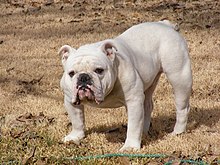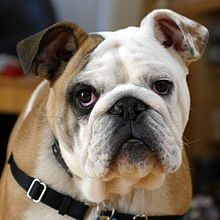English Bulldog
Bulldog is the name for a breed of dog commonly referred to as the English Bulldog. Other Bulldog breeds include the American Bulldog, Olde English Bulldogge and the French Bulldog. The Bulldog is a muscular heavy dog with a wrinkled face and a distinctive pushed-in nose. The American Kennel Club (AKC), The Kennel Club (UK) and the United Kennel Club (UKC) oversee breeding standards.
Appearance
The Bulldog is a breed with characteristically wide head and shoulders along with a pronounced mandibular prognathism. There are generally thick folds of skin on a Bulldog's brow; round, black, wide-set eyes; a short muzzle with characteristic folds called "rope" above the nose; hanging skin under the neck; drooping lips and pointed teeth and occasionally, an underbite. The coat is short, flat and sleek, with colors of red, fawn, white, brindle, andpiebald.
In the UK, the breed standards are 50 pounds for a male and 40 pounds for a female.[1] In the US, a typical mature male weighs approximately 45–55 pounds. Mature females weigh in at approximately 45 pounds.
Bulldogs are one of the few breeds whose tail is naturally short and either straight or screwed and thus is not cut or docked as with some other breeds. A straight tail is a more desirable tail according the breed standard set forth by the BCA if it is facing downward, not upward.
History
The term "Bulldog" was first mentioned in literature around 1500, the oldest spelling of the word being Bondogge and Bolddogge. The first reference to the word with the modern spelling is dated 1631 or 1632 in a letter by a man named Preswick Eaton where he writes: "procuer mee two good Bulldogs, and let them be sent by ye first shipp".[12] The name "bull" was applied because of the dog's use in the sport of bull baiting. This entailed the setting of dogs (after placing wagers on each dog) onto a tethered bull. The dog that grabbed the bull by the nose and pinned it to the ground would be the victor. It was common for a bull to maim or kill several dogs at such an event, either by goring, tossing or trampling. Over the centuries dogs used for bull-baiting developed the stocky bodies and massive heads and jaws which typify the breed as well as a ferocious and savage temperament. Bull-baiting – along with bear-baiting – reached the peak of their popularity in England in the early 1800s until they were both made illegal by the Cruelty to Animals Act 1835. This amended the existing legislation to protect animals from mistreatment and included (as 'cattle') bulls, dogs, bears and sheep, so that bull and bear-baiting as well as cockfighting became prohibited. Therefore, the Old English Bulldog had outlived its usefulness in England as a sporting animal and its active or 'working' days were numbered. However, emigrants did have a use for such dogs in the New World. In mid-17th century New York, Bulldogs were used as a part of a city-wide round-up effort led by governor Richard Nicolls. Because cornering and leading wild bulls was dangerous, Bulldogs were trained to seize a bull by its nose long enough for a rope to be secured around its neck.[13] Bulldogs as pets were continually promoted by dog dealer Bill George.[14]
Despite slow maturation so that growing up is rarely achieved by two and a half years, bulldogs' lives are relatively short and at five to six years of age they are starting to show signs of aging.
In time, the original old English Bulldog was crossed with the pug. The outcome was a shorter, wider dog with a brachycephalic skull. Though today's Bulldog looks tough, he cannot perform the job he was originally created for as he cannot withstand the rigors of running and being thrown by a bull, and also cannot grip with such a short muzzle.
The oldest single breed specialty club is The Bulldog Club (England), which was formed in 1878. Members of this club met frequently at the Blue Post pub on Oxford Street in London. There they wrote the first standard of perfection for the breed. In 1894 the two top Bulldogs, King Orry and Dockleaf, competed in a contest to see which dog could walk 20 miles. King Orry was reminiscent of the original Bulldogs, lighter boned and very athletic. Dockleaf was smaller and heavier set, more like modern Bulldogs. King Orry was declared the winner that year finishing the 20 mile walk while Dockleaf collapsed.[15]
At the turn of the 20th century, Ch. Rodney Stone became the first Bulldog to command a price of $5000 when he was bought by controversial Irish-American political figure Richard Croker.
 | |||||||
| Other names | English Bulldog | ||||||
|---|---|---|---|---|---|---|---|
| Country of origin | England | ||||||
| |||||||
| |||||||




No comments:
Post a Comment